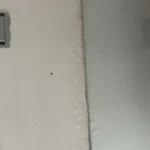What Causes Blisters to Occur in Microcement Surfaces?
Because Microne, the product that we recommend for bathrooms, is 100% waterproof, it won’t allow any water to penetrate through it. Which is absolutely necessary in bathrooms, wet rooms and showers.
If water gets to the underside of the microcement, however, it will become trapped under the surface & if the water pressure builds up, it could result in a blister of water forming.
Blisters occur when water is trapped under the surface of the microcement.
Most often water gets behind the microcement through open edges around the boundaries of the microcement or around the shower waste.
But it could also be caused by leaking pipes, moisture in the substrate or rising damp.
Traditional Microcements Need to Breathe
Traditional Microcements, like Microdur need to breathe. If a wet item, is left on the surface for prolonged periods of time, the trapped moisture can cause darkness or blisters to occur. Often, once the item is removed, the microcement surface will slowly recover over time, so don’t be in a hurry to start repair work in this case.
How Can I Repair Blisters in Microcement?
First, the source of the water needs to be identified and eliminated so that the microcement can dry out.
Check around the shower waste and along the edges of the microcement surface to see if there’s anywhere that water could be getting behind it. Before you do any repair work, you need to let the surface dry out fully, so keep the area dry and leave any gaps exposed so the air can get to it.
Repairing Small Blisters in Microcement
To minimise the damage to the microcement, you can prick each blister with a pin, and gently push on them to release the moisture. Then wait until the microcement is completely dry, we’d expect this to take at least 48 hours, depending on heating & ventilation, but you may be able to speed this up by using a hair dryer on a medium heat.
Once dry, if the blisters will push flat, and you are happy with the visual appearance, you can apply 2 coats of sealer over the pinholes.
Small repairs can be done by touching up the microcement.
Dab small amounts of the colour matched product into any areas that need touching up. This is very difficult to do seamlessly, but should hopefully make it appear less obvious. Less is definitely more when it comes to touching up microcement. Use a sponge to dab on small amounts of product and feather it into the existing surface, rather than trowelling on big sections.
Before you allow water to touch the surface again, make sure you’ve fixed the source of the problem, by applying silicone along any open edges & resealing the surface.
Repairing Larger Areas of Water Damage
For big blisters, where a lot of water has got underneath the microcement, it may be better to sand the surface back and let it dry out fully, Again, the microcement must be fully dried out before you apply anything on top of it.
Once dry, check that the surface is strong & well consolidated, it may need sanding more to achieve this. You’ll need to recoat the entire surface that the damage is on as Microcement is notoriously difficult to patch seamlessly.
Give the surface a good sand to give it a key, prime any sealed areas with Primer 100 and then go over it with 2 top coats (you will probably find that the 1st coat goes on a bit grainy, which is why we recommend 2) and then reapply the sealers.
Again, all open edges need to be well sealed and finished with silicone as appropriate to prevent water getting behind the microcement in future.

